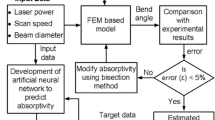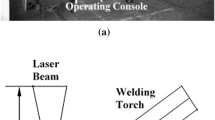Abstract
An artificial neural network (ANN) model of laser-assisted bending is developed based on the data obtained from a finite element method (FEM) model. FEM model is validated with the experiments. In the experimental setup, the sheet is clamped like a cantilever beam with mechanical load on the free end. A laser beam scans the bend line for reducing the flow stress of the material locally. ANN considers four process parameters viz., laser power, mechanical load, distance of the scan-line from the free end, and scan speed. The ANN predicts the most likely, upper, and lower estimates of the bend angle. Commercial package MATLAB® is used for developing the ANN model. First, a multilayer perceptron (MLP) neural network is trained and tested using the data from the FEM model. Using the best fit model of the MLP, additional data are generated for training a radial basis function (RBF) neural network. The RBF neural network is tested and validated against experimental data and subsequently used for obtaining the most likely, lower, and upper estimates of bend angle as a function of the considered process parameters. A parametric study is also carried out based on the RBF neural network model. Finally, it is shown that the neural network can be used for the inverse prediction using the bisection method.
















Similar content being viewed by others
References
Dixit US, Joshi SN, Kumar VH (2012) Microbending with laser. In: Jain VK (ed) Micromanufacturing processes. CRC Press, Boca Raton, pp 283–303
Eideh A, Dixit US, Echempati R (2015) A simple analytical model of laser bending process. In: Joshi SN, Dixit US (eds) Lasers based manufacturing: 5th international and 26th all India manufacturing technology, design and research conference, AIMTDR 2014. Springer, New Delhi, pp 1–15
Lambiase F, Di Ilio A, Paoletti A (2015) Optimization of multi-pass laser bending by means of soft computing techniques. Procedia CIRP 33:503–508
Edwardson SP, Abed E, Carey C, Edwards KR, Dearden G, Watkins KG(2007) Factors influencing the bend per pass in multi-pass laser forming. In: Geiger M, Otto A, Schimidt M (eds) Laser assisted net shape engineering 5, proceedings of LANE 2007, pp 557–568
Kratky A (2007) Laser assisted forming techniques. In: Schuöcker D (eds) XVI international symposium on gas flow, chemical lasers, and high-power lasers, Gmunden, Austria, September 4, 2007. Proceedings of the SPIE, vol 6346, article id. 634615
Dearden G, Edwardson SP (2003) Some recent developments in two-and three-dimensional laser forming for ‘macro’ and ‘micro’ applications. J Opt A: Pure Appl Opt 5(4):S8
Roohi AH, Gollo MH, Naeini HM (2012) External force-assisted laser forming process for gaining high bending angles. J Manuf Process 14(3):269–276
Bammer F, Schuöcker D, Schumi T, Holzinger B, Humenberger G (2011) A diode-laser-system for laser-assisted bending of brittle materials. Adv Opt Technol Article ID 321807
Dixit US, Joshi SN, Kant R (2015) Laser forming systems: a review. Int J Mechatron Manuf Syst 8(3–4):160–205
Samm K, Terzi M, Ostendorf A, Wulfsberg J (2009) Laser-assisted micro-forming process with miniaturised structures in sapphire dies. Appl Surf Sci 255(24):9830–9834
Kant R, Joshi SN (2013) Finite element simulation of laser assisted bending with moving mechanical load. Int J Mechatron Manuf Syst 6(4):351–366
Yanjin G, Sheng S, Guoqun Z, Yiguo L (2003) Finite element modeling of laser bending of pre-loaded sheet metals. J Mater Process Technol 142(2):400–407
Gisario A, Barletta M, Conti C, Guarino S (2011) Springback control in sheet metal bending by laser-assisted bending: experimental analysis, empirical and neural network modeling. Opt Lasers Eng 49(12):372–1383
Fetene BN, Dixit US (2015) A finite element analysis of laser assisted mechanical bending of aluminum alloy sheets along with inverse determination of input parameters. In: National Conference on emerging technologies’ contribution in promoting defense and industry (NCETCPDIC). Defense University, College of Engineering, Bishoftu, Ethiopia, pp 173 − 178
Dragos V, Dan V, Kovacevic R (2000) Prediction of the laser sheet bending using neural network. In: IEEE international symposium on circuits and systems May 28–31, Geneva, pp III-686–III-689
Cheng PJ, Lin SC (2000) Using neural networks to predict bending angle of sheet metal formed by laser. Int J Mach Tools Manuf 40(8):1185–1197
Casalino G, Ludovico AD (2002) Parameter selection by an artificial neural network for a laser bending process. Proc Inst Mech Eng Part B J Eng Manuf 216(11):1517–1520
Barletta M, Gisario A, Guarino S (2009) Hybrid forming process of AA 6108 T4 thin sheets: modeling by neural network solutions. Proc Inst Mech Eng Part B J Eng Manuf 223(5):535–545
Maji K, Pratihar DK, Nath AK (2013) Analysis and synthesis of laser forming process using neural networks and neuro-fuzzy inference system. Soft Comput 17(5):849–865
Maji K, Pratihar DK, Nath AK (2014) Laser forming of a dome shaped surface: experimental investigations, statistical analysis and neural network modeling. Opt Lasers Eng 53(2014):31–42
Maji K, Pratihar DK, Nath AK (2014) Analysis of pulsed laser bending of sheet metal using neural networks and neuro-fuzzy system. Proc Inst Mech Eng Part B J Eng Manuf 0954405414522212
Pérez JA, González M, Dopico D (2010) Adaptive neurofuzzy ANFIS modeling of laser surface treatments. Neural Comput Appl 19(1):85–90. doi:10.1007/s00521-009-0259-x
Kohli A, Dixit US (2005) A neural network based methodology for the prediction of surface roughness in a turning process. Int J Adv Manuf Technol 25(1):118–129
Kant R, Joshi SN, Dixit US (2015) An integrated FEM-ANN model for laser bending process with inverse Estimation of absorptivity. Mech Adv Mater Modern Process. 1, Article 6
Sarma DK, Dixit US (2007) A comparison of dry and air-cooled turning of grey cast iron with mixed oxide ceramic tool. J Mater Process Technol 190(1):160–172
Garg A, Sastry PS, Pandey M, Dixit US, Gupta SK (2007) Numerical simulation and artificial neural network modeling of natural circulation boiling water reactor. Nucl Eng Des 237(3):230–239
Sonar DK, Dixit US, Ojha DK (2006) The application of a radial basis function neural network for predicting the surface roughness in a turning process. Int J Adv Manuf Technol 27(7–8):661–666
Singh K, Ray AK, Joshi SN, Dixit US(2013) Effect of lime and graphite grease coatings on the absorptivity of mild steel sheet in line heating by CO2 laser. In: Proceedings of national conference on recent advancements in mechanical engineering, 8–9 November, NERIST, Nirjuli, India
Chen G, Xu X, Poon CC, Tam AC (1999) Experimental and numerical studies on microscale bending of stainless steel with pulsed laser. J Appl Mech 66(3):772–779
Zhang L, Reutzel EW, Michaleris P (2004) Finite element modeling discretization requirements for the laser forming process. Int J Mech Sci 46(4):623–637
Dieter GE (1991) Engineering design: a materialistic and processing approach, 2nd edn. McGraw-Hill, New York
Lawrence M, Petterson A (2002) Brain maker user’s manual, 7th edn. California Scientific Software, Nevada City
Risbood KA, Dixit US, Sahasrabudhe AD (2003) Prediction of surface roughness and dimensional deviation by measuring cutting forces and vibrations in turning process. J Mater Process Technol 132(1):203–214
Author information
Authors and Affiliations
Corresponding author
Rights and permissions
About this article
Cite this article
Fetene, B.N., Shufen, R. & Dixit, U.S. FEM-based neural network modeling of laser-assisted bending. Neural Comput & Applic 29, 69–82 (2018). https://doi.org/10.1007/s00521-016-2544-9
Received:
Accepted:
Published:
Issue Date:
DOI: https://doi.org/10.1007/s00521-016-2544-9




